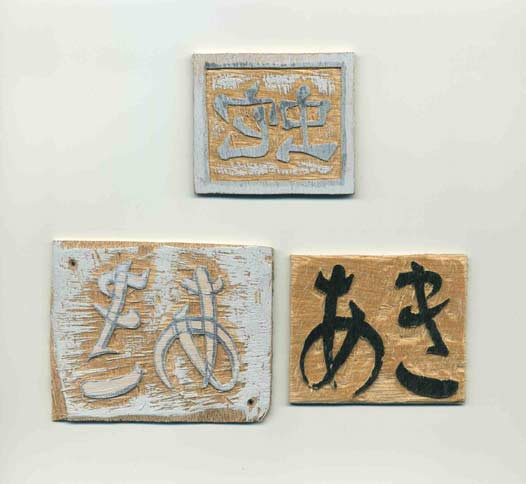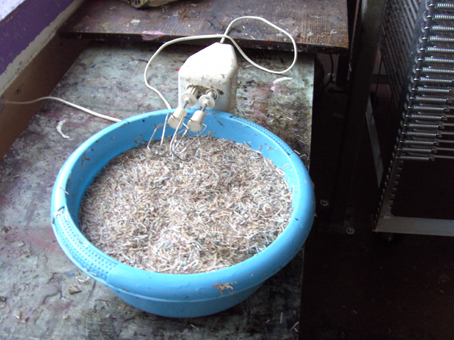|
"Vilnius European Cultural Capital 2009"   Based on the assumption that they have all the information I have on fore-hand given on the internet, I simply start working. The posted packet with papers, lino, some wood, and thingy-things has arrived, so all things needed are there to be divided 'for the needing' so to speak - but, indeed, rather to be an inspiration to find quality in whatever an artist might find in front of him. As the thing gets started I fumble with a few binding-tricks, and ask the students to make fit, whatever their (paper)measures in printing are, the booklets to somewhat postcard size - there should be something of a collection in the end, and a general size is the easiest way to 'not ruling, but never the less keeping together'. An idea to have a most basical idea for 'a collection' - that works well with the theme 'fairings'. Well, the idea that the internet-pages had been fully understood was not exactly right - I heard something of a grumble that 'we would not get it all together' any-way, but that was something I stupidly failed to grasp at the time. It did not last long to find the ink not having much drying qualities, so the 12 editions of 25 copies did need something of an organization; I had to find there that these students do not really have the most graphic of graphical ideas: 'working together to make a personal things coming out right'. Apparently words in both languages can be pretty much the same, which was their reason to choose for a writng-form that would make it more interesting. And, yes - as these things are, there was that little thing that is soo much in all of us with forgetting that things to be cut and printed from undergo a mirroring process; nothing much, but for the technique quintessential - and furthermore it shows all the basic problems about composition and how to go about it in the first place. Such things are a good laugh even more because there will never be anyone without the experience; it is what every craftsman knows to be a good start.  An atelier is not just a place where things are (or indeed things are not), but it is the well organized collection of extra hands in the right place to be activated when the artists mind calls for it; the 'mise en place' as a cook would call it is of utmost importance. Academy ateliers never are such places!, one has to fight for it to get something like 'a soul' in a few days only. An artist has to learn this when he is (as most artists are) going places in order 'to get around' (something very healthy for his art).  I'm beginning to see the real meaning of the addition 'and resourceful' by neighbouring Wayne Crothers to my 'Tja, one may need to be flexible', when entering the class-room. A group of students begin by shredding old newspapers and what ever bits of paper that comes their way. Sooner than expected the 'humble' nature of this work seems to loose attraction; but I'm afraid that most certainly this is the sort of 'zen-lesson' that has be learnt. I belong to the (anciently) old-fashioned artists that makes his own oil-paint by endlessly rubbing the pigments into the oils, as long as each different colour needs to be mixed and rubbed in each different oil. The idea of 'practise making the master' has in my case developed into a feeling of love for my materials as they are the friends that should make it possible for me to have 'free-way' with 'the stuff' in my fingers in order to have my mind concentrate on the philosophy that should make it worth to look at my 'things' when, later, I'm ready and gone and nothing but my work is left of me. This idea of ready made materials is a marketing idea to get amateurs started. Real artists start their adventures in art at the very basis of things, and we study the history of our ancesters: 'course I know why Goya coloured the basic grounds of his portraits (or any other of his paintings); course I know what is under Rembrandt's 'Jewish Bride'; not as a result of seeing the x-rays, but because I have learned to look with a lover's eye through the skin. These paintings would not have been possible on white and prepared canvasses.  But these may come in later, as all material I have brought is going to stay for any student that would have an interest to continue after these classes, or for that matter, take up the craft and make it into an art.  Difficult to believe how 'Sovjet' a 'Sovjet woodcut' is - more difficult even to see how an 'old-style' artist could be 're-set' into a new-style artist (something I do actually hear a lot about), whilst on the other hand there are such a host of good artists that worked their way before and work their way now, without the one or the other nonsens getting in the way. And as always in any academy in Europe I fail to see the point of not having real art openly on display, and standing around everywhere on corridoors and God knows where. What is it with these places that make me wonder if art is something secret. Would it really be that professors are afraid to influence students by debating the real thing when on the walls? If anywhere, it is here where good and real art should be in every corner, and should be open to debate to everyone. It is here where art should be vulnarable, not just because of being art as such, but also to teach students and all society around them to respect art or properly debate it. Like it or not: If you'd love it - tell me exactly why, without the blurr of a vague time-capsuled-laguage. If you don't like it, well tell me in good strong words what exactly it is that you don't like; taste would not do. If that would not be an ultimate lesson to learn to have proper conversations on art, I don't know what is. INDEX of the Joseph Joh'n' Pages |